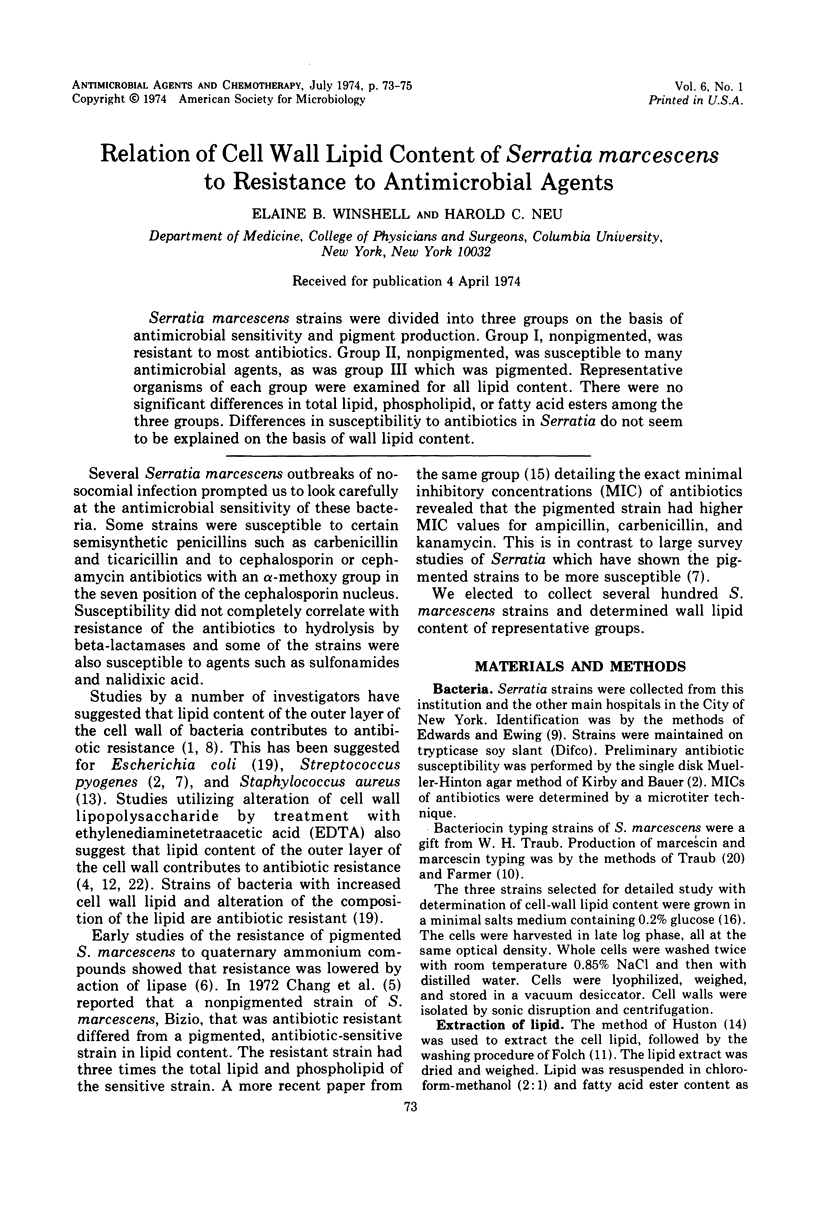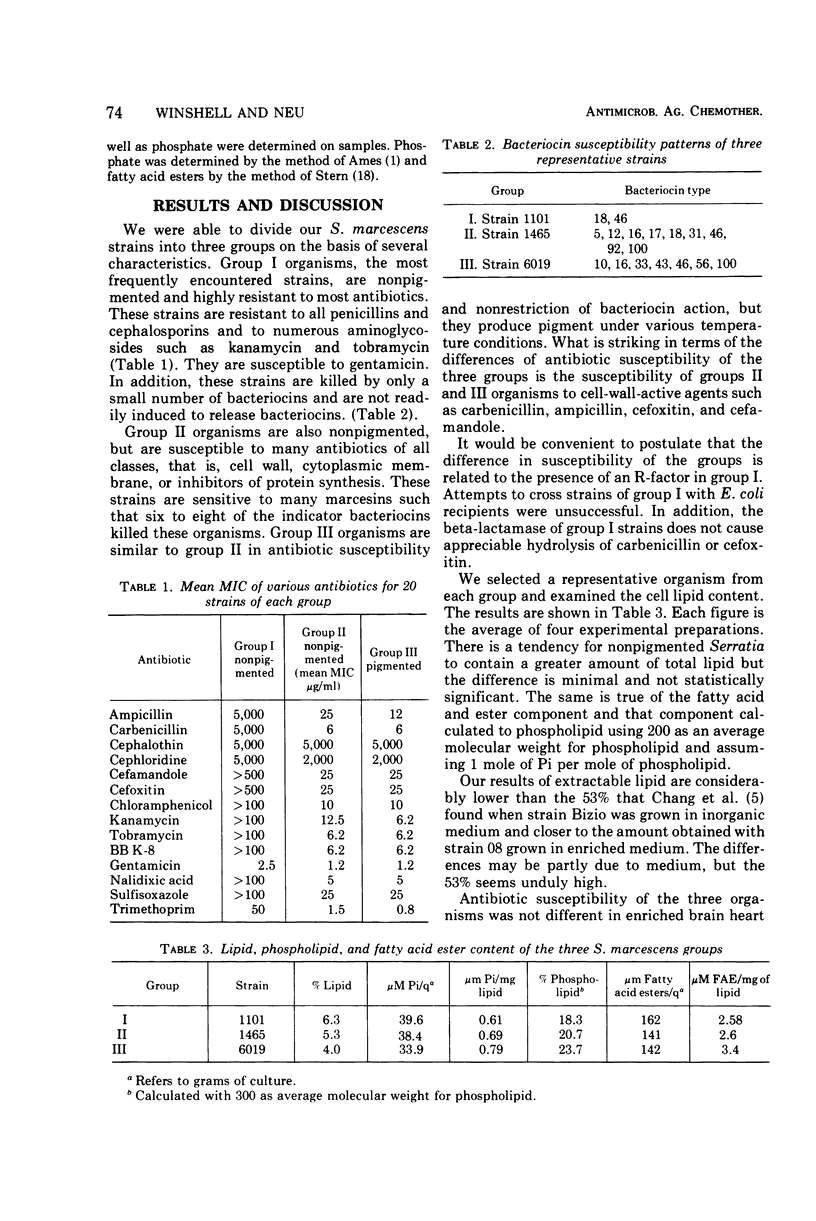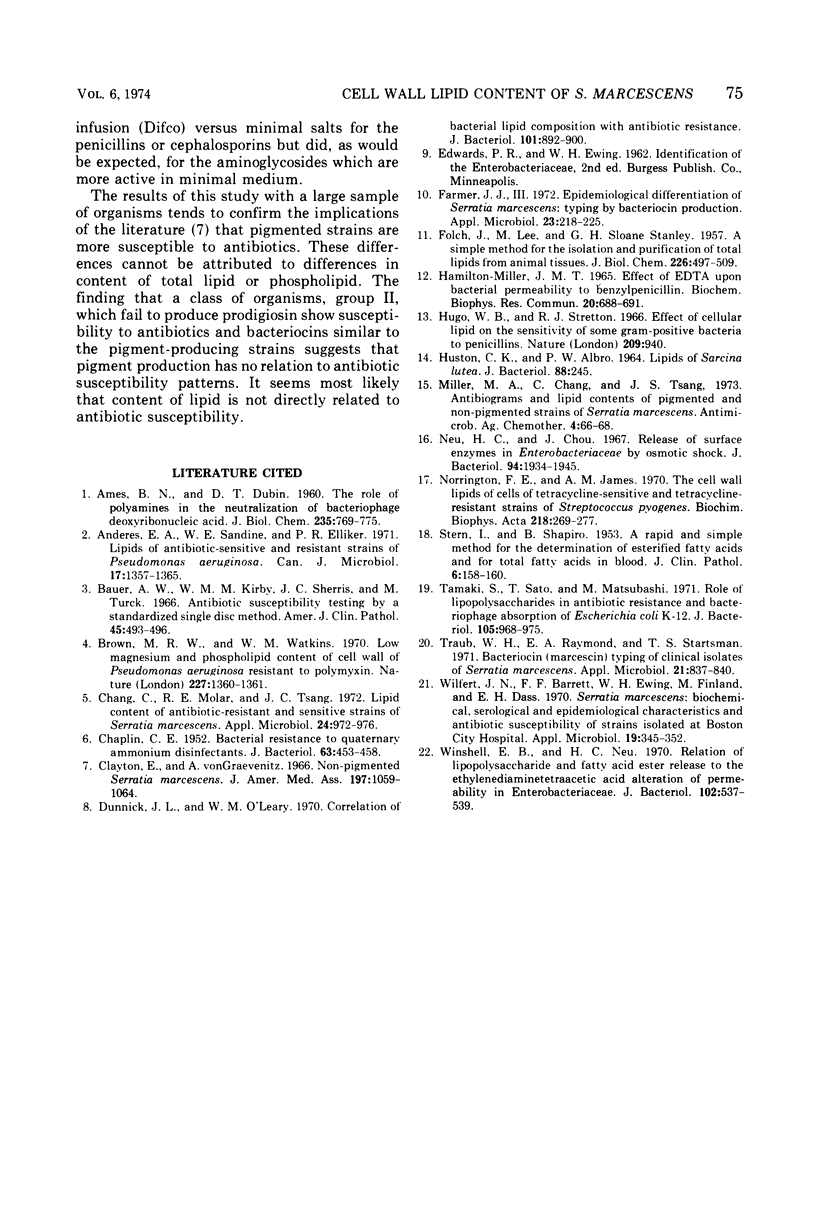Abstract
Serratia marcescens strains were divided into three groups on the basis of antimicrobial sensitivity and pigment production. Group I, nonpigmented, was resistant to most antibiotics. Group II, nonpigmented, was susceptible to many antimicrobial agents, as was group III which was pigmented. Representative organisms of each group were examined for all lipid content. There were no significant differences in total lipid, phospholipid, or fatty acid esters among the three groups. Differences in susceptibility to antibiotics in Serratia do not seem to be explained on the basis of wall lipid content.
Full text
PDF


Selected References
These references are in PubMed. This may not be the complete list of references from this article.
- AMES B. N., DUBIN D. T. The role of polyamines in the neutralization of bacteriophage deoxyribonucleic acid. J Biol Chem. 1960 Mar;235:769–775. [PubMed] [Google Scholar]
- Anderes E. A., Sandine W. E., Elliker P. R. Lipids of antibiotic-sensitive and -resistant strains of Pseudomonas aeruginosa. Can J Microbiol. 1971 Nov;17(11):1357–1365. doi: 10.1139/m71-217. [DOI] [PubMed] [Google Scholar]
- Bauer A. W., Kirby W. M., Sherris J. C., Turck M. Antibiotic susceptibility testing by a standardized single disk method. Am J Clin Pathol. 1966 Apr;45(4):493–496. [PubMed] [Google Scholar]
- Brown M. R., Watkins W. M. Low magnesium and phospholipid content of cell wals of Pseudomonas aeruginosa resistant to polymyxin. Nature. 1970 Sep 26;227(5265):1360–1361. doi: 10.1038/2271360a0. [DOI] [PubMed] [Google Scholar]
- CHAPLIN C. E. Bacterial resistance to quaternary ammonium disinfectants. J Bacteriol. 1952 Apr;63(4):453–458. doi: 10.1128/jb.63.4.453-458.1952. [DOI] [PMC free article] [PubMed] [Google Scholar]
- Chang C. Y., Molar R. E., Tsang J. C. Lipid content of antibiotic-resistant and -sensitive strains of Serratia marcescens. Appl Microbiol. 1972 Dec;24(6):972–976. doi: 10.1128/am.24.6.972-976.1972. [DOI] [PMC free article] [PubMed] [Google Scholar]
- Clayton E., Von Graevenitz A. Nonpigmented Serratia marcescens. JAMA. 1966 Sep 26;197(13):1059–1064. [PubMed] [Google Scholar]
- Dunnick J. K., O'Leary W. M. Correlation of bacteria lipid composition with antibiotic resistance. J Bacteriol. 1970 Mar;101(3):892–900. doi: 10.1128/jb.101.3.892-900.1970. [DOI] [PMC free article] [PubMed] [Google Scholar]
- FOLCH J., LEES M., SLOANE STANLEY G. H. A simple method for the isolation and purification of total lipides from animal tissues. J Biol Chem. 1957 May;226(1):497–509. [PubMed] [Google Scholar]
- Farmer J. J., 3rd Epidemiological differentiation of Serratia marcescens: typing by bacteriocin production. Appl Microbiol. 1972 Feb;23(2):218–225. doi: 10.1128/am.23.2.218-225.1972. [DOI] [PMC free article] [PubMed] [Google Scholar]
- Hamilton-Miller J. M. Effect of EDTA upon bacterial permeability to benzylpenicillin. Biochem Biophys Res Commun. 1965 Sep 22;20(6):688–691. doi: 10.1016/0006-291x(65)90070-7. [DOI] [PubMed] [Google Scholar]
- Hugo W. B., Stretton R. G. Effect of cellular lipid on the sensitivity of some Gram-positive bacteria to penicillins. Nature. 1966 Feb 26;209(5026):940–940. doi: 10.1038/209940a0. [DOI] [PubMed] [Google Scholar]
- Miller M. A., Chang C. Y., Tsang J. C. Antibiograms and lipid contents of pigmented and nonpigmented strains of Serratia marcescens. Antimicrob Agents Chemother. 1973 Jul;4(1):66–68. doi: 10.1128/aac.4.1.66. [DOI] [PMC free article] [PubMed] [Google Scholar]
- Neu H. C., Chou J. Release of surface enzymes in Enterobacteriaceae by osmotic shock. J Bacteriol. 1967 Dec;94(6):1934–1945. doi: 10.1128/jb.94.6.1934-1945.1967. [DOI] [PMC free article] [PubMed] [Google Scholar]
- STERN I., SHAPIRO B. A rapid and simple method for the determination of esterified fatty acids and for total fatty acids in blood. J Clin Pathol. 1953 May;6(2):158–160. doi: 10.1136/jcp.6.2.158. [DOI] [PMC free article] [PubMed] [Google Scholar]
- Tamaki S., Sato T., Matsuhashi M. Role of lipopolysaccharides in antibiotic resistance and bacteriophage adsorption of Escherichia coli K-12. J Bacteriol. 1971 Mar;105(3):968–975. doi: 10.1128/jb.105.3.968-975.1971. [DOI] [PMC free article] [PubMed] [Google Scholar]
- Traub W. H., Raymond E. A., Startsman T. S. Bacteriocin (Marcescin) typing of clinical isolates of Serratia marcescens. Appl Microbiol. 1971 May;21(5):837–840. doi: 10.1128/am.21.5.837-840.1971. [DOI] [PMC free article] [PubMed] [Google Scholar]
- Wilfert J. N., Barrett F. F., Ewing W. H., Finland M., Kass E. H. Serratia marcescens: biochemical, serological, and epidemiological characteristics and antibiotic susceptibility of strains isolated at Boston City Hospital. Appl Microbiol. 1970 Feb;19(2):345–352. doi: 10.1128/am.19.2.345-352.1970. [DOI] [PMC free article] [PubMed] [Google Scholar]
- Winshell E. B., Neu H. C. Relation of lipopolysaccharide and fatty acid ester release to the ethylenediaminetetraacetic acid alteration of permeability in enterobacteriaceae. J Bacteriol. 1970 May;102(2):537–539. doi: 10.1128/jb.102.2.537-539.1970. [DOI] [PMC free article] [PubMed] [Google Scholar]


